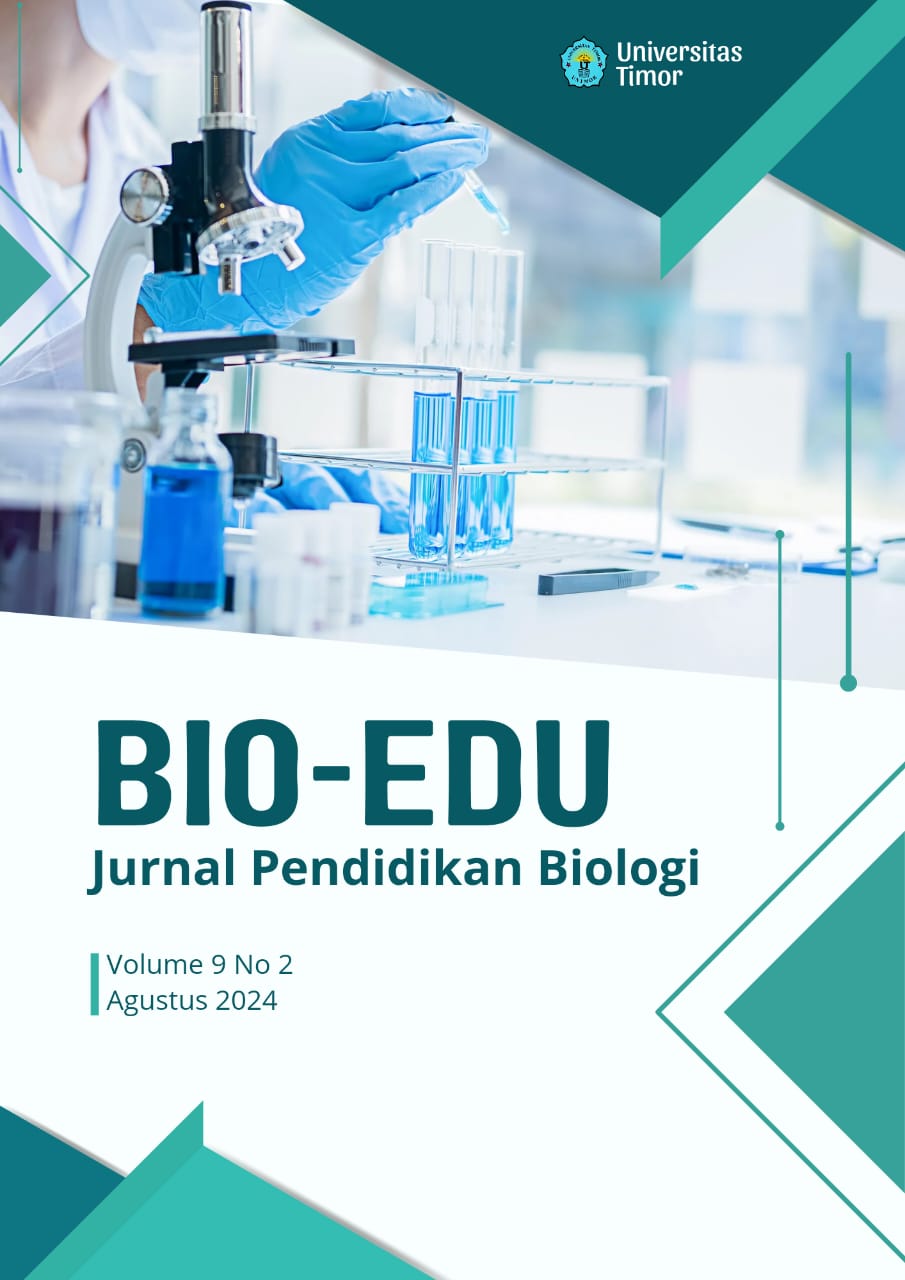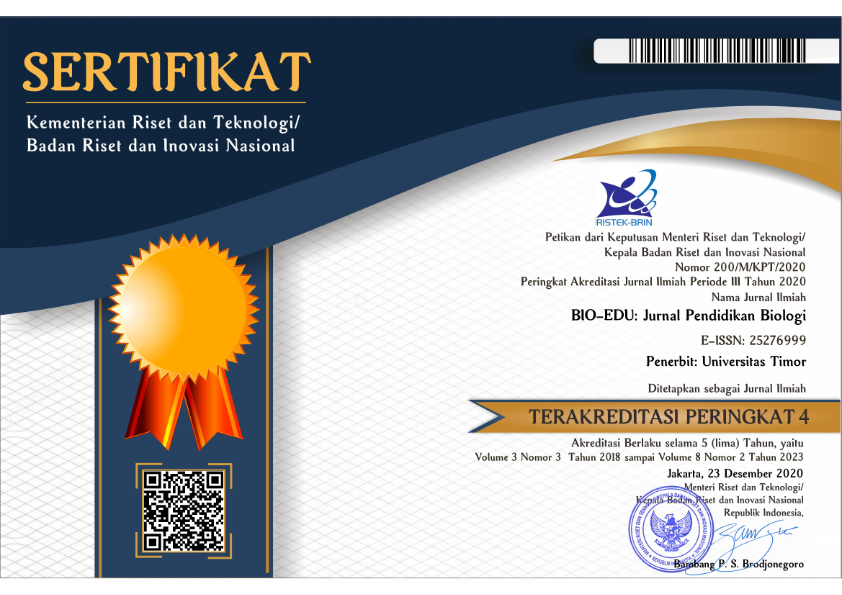Kajian Kualitas Air berdasarkan Keanekaragaman Plankton di Muara Sungai Donan
DOI:
https://doi.org/10.32938/jbe.v9i2.7440Keywords:
Pollution, Phytoplankton, Donan River EstuaryAbstract
The Donan River estuary is the area where the Donan River meets the Nusakambangan Strait, has a level of pollution that shows an increase, one of which is caused by human activity. Phytoplankton has an important role in determining the status of waters by knowing the diversity and types of plankton. The research aims to determine the community structure of the phytoplankton as a biological indicator and determine the condition of the Donan River Estuary based on the Diversity Index. This research was conducted out in April-May 2024. The sampling method was a sample survey. The results of this research show that the phytoplankton abundance of the Donan River estuary ranges from 42-382 ind/L, which means it is oligotrophic. The results of phytoplankton identification showed that many Bacillariophyceae and Cyanophyceae classes were found. The diversity index value at station 1 is 1.199 and at station 2 is 1.623. The diversity index value shows that the Donan River Estuary has moderate phytoplankton community stability and water quality is moderately polluted. Based on the uniformity index at station 2 the uniformity is more even and based on the dominance index there is no dominant genus.
References
Cahyaningtyas, I., Hutabarat, S., dan Soedarsono, P. (2013). Studi analisa plankton untuk menentukan tingkat pencemaran di muara Sungai Babon Semarang. Management of Aquatic Resources Journal (MAQUARES), 2(3), 74-84.
Guiry, M.D., dan Guiry, G.M. 2012. AlgaeBase. World-wide electronic publication, National University of Ireland, Galway. Retrieved from https://www.algaebase.org
Jena, M., Bock, C., Behera, C., Adhikary, S. P., dan Krienitz, L. (2014). Strain survey on three continents confirms the polyphyly of the genus Pediastrum (Hydrodictyaceae, Chlorophyceae). Fottea, 14(1), 63-76.
Kooistra, W. H., Sarno, D., Hernández-Becerril, D. U., Assmy, P., Di Prisco, C., dan Montresor, M. (2010). Comparative molecular and morphological phylogenetic analyses of taxa in the Chaetocerotaceae (Bacillariophyta). Phycologia, 49(5), 471-500.
Komárek, J. (2013). Süßwasserflora von Mitteleuropa, Bd. 19/3: Cyanoprokaryota 3. Teil/3rd part: Heterocytous Genera. Süßwasserflora von Mitteleuropa. Spektrum Academischer Verlag, Heidelberg.
Lee, T. A., Rollwagen-Bollens, G., Bollens, S. M., dan Faber-Hammond, J. J. (2015). Environmental influence on cyanobacteria abundance and microcystin toxin production in a shallow temperate lake. Ecotoxicology and environmental safety, 114, 318-325.
Lubis, A. R. (2021). Analisis Kelimpahan Plankton di Sungai Linggahara Sumatera Utara. Jurnal Pionir LPPM Universitas Asahan, 7(1), 287–293
Martino, A. D., Meichenin, A., Shi, J., Pan, K., & Bowler, C. (2007). Genetic and phenotypic characterization of Phaeodactylum tricornutum (Bacillariophyceae) accessions1. Journal of Phycology, 43(5), 992-1009.
McManus, H. A., Lewis, L. A., dan Schultz, E. T. (2011). distinguishing multiple lineages of Pediastrum duplex with morphometrics and a proposal for lacunastrum gen. nov. Journal of phycology, 47(1), 123-130.
Miruka, J. B., Getabu, A., Sitoki, L., James, O., Mwamburi, J., George, O., ... dan Odoli, C. (2021). Water quality, phytoplankton composition and microcystin concentrations in Kisumu Bay (Kenya) of Lake Victoria after a prolonged water hyacinth infestation period. Lakes dan Reservoirs: Research dan Management, 26(4), e12380.
Odum, Fundamentals of Ecology, 3rd ed. Philadelphia: W. B. Sounder Co, 1971.
Purbani, D. C., Ambarwati, W., Kusuma, A. B., dan Herliany, N. E. (2019). Identification of marine microalgae from Tambrauw, West Papua. Jurnal Ilmu Dan Teknologi Kelautan Tropis, 11(3), 777-791.
Rahman, A., Haeruddin, H., Ghofar, A., dan Purwanti, F. (2022). Kondisi Kualitas Air Dan Struktur Komunitas Diatom (Bacillariophyceae) di Sungai Babon. Saintek Perikanan: Indonesian Journal of Fisheries Science and Technology, 18(2), 125-129.
Rosanti, L dan Harahap A (2022). Keberadaan Plankton sebagai Indikator Pencemaran.
Bioedusains : Jurnal Pendidikan Biologi dan Sains. 5(1), 182-188
Rumondang dan E Paujiah (2019). Kondisi Plankton pada Tambak Ikan Kerapu di Mesjid Lama Kecamatan Talawi Kabupaten Batu Bara, Sumatera Utara> Depik Jurnal Ilmu- ilmu Perairan, Pesisir dan Perikanan, 9(1), 107-118
Shabrina, F. N., Saptarini, D., dan Setiawan, E. (2020). Struktur Komunitas Plankton di Pesisir Utara Kabupaten Tuban. Jurnal Sains Dan Seni ITS, 9(2), 5–10.
Spaulding, S. A., dan Stoermer, E. F. (1997). Taxonomy and distribution of the genus Muelleria Frenguelli. Diatom research, 12(1), 95-113.
Y. Linus, Salwiyah, dan N. Irawati (2016). Status Kesuburan perairan berdasarkan kandungan klorofil-a di Perairan Bungkutoko Kota Kendari. Manajemen Sumber Daya Perairan. 2(1) , 101-111
Wongsawad, P., dan Peerapornpisal, Y. (2015). Morphological and molecular profiling of Spirogyra from northeastern and northern Thailand using inter simple sequence repeat (ISSR) markers. Saudi journal of biological sciences, 22(4), 382-389.
Downloads
Published
Issue
Section
License
Copyright (c) 2024 BIO-EDU: Jurnal Pendidikan Biologi

This work is licensed under a Creative Commons Attribution-ShareAlike 4.0 International License.
The Authors submitting a manuscript do so on the understanding that if accepted for publication, the copyright of the article shall be assigned to BIO-EDU: Jurnal Pendidikan Biologi and Departement of Biology Education, Universitas Timor as the publisher of the journal. Copyright encompasses rights to reproduce and deliver the article in all form and media, including reprints, photographs, microfilms, and any other similar reproductions, as well as translations.
BIO-EDU journal and Departement Biology Education, Universitas Timor, and the Editors make every effort to ensure that no wrong or misleading data, opinions, or statements be published in the journal. In any way, the contents of the articles and advertisements published in BIO-EDU are the sole and responsibility of their respective authors and advertisers.
Users of this website will be licensed to use materials from this website following the Creative Commons Attribution-ShareAlike 4.0 International License.



















